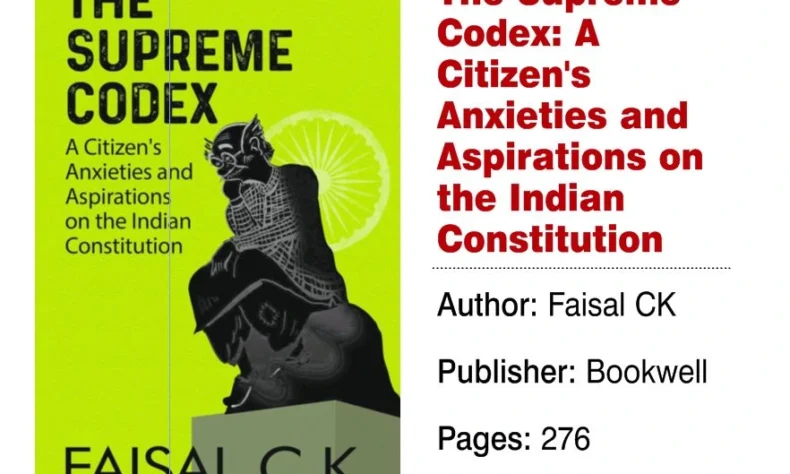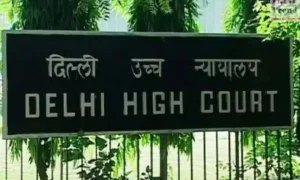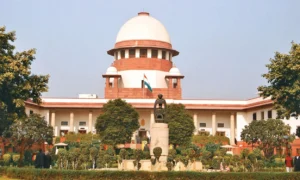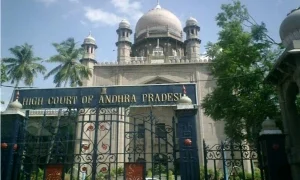
By Prof Upendra Baxi
On the face of it, this is one more book on Indian constitutionalism. But what makes it distinctive is that it (comprising 60 press articles) is written during 2018-2025 by Faisal CK , an incumbent deputy law secretary of Kerala. While India is blessed with the continuation of normative labours of superannuated Justices, it is very rare to come across an anthology of critical essays by a serving bureaucrat. I urge the reader to find the bureaucratic voice, as is overlaid also with the voice the anguished citizen who is also a seasoned journalist.
The Supreme Codex: A Citizen’s Anxieties and Aspirations on Indian Constitution (Delhi, Bookwell, 2025) makes an important contribution to contemporary studies in Indian constitutionalism. The author means by Supreme Codex, the “Paramount Parchment of India” that is the Indian constitution and ways in which the High Courts and the Supreme Court have deployed and developed constitutionalism. Some readers of the national dailies will be familiar with Faisal CK’s writings as these appeared there, but it is good to have this critical anthology which incorporates them all.
The short essays are eminently readable, but behind these lies considerable wit and wisdom. A good grasp of the spirit of Constitution is in ample evidence all throughout, though centrepieces on the editorial page do not allow the luxury of detailed analysis of the many-sided judicial discourse. Of course, one may differ from some of the opinions and reflections but, as is well known, a democratic culture is based on a socially responsible, and responsive, mediation of honest differences and disagreements. It is indubitable that Faisal invites counter responses from his readers. A democratic order, all said and done, is never a soliloquy of power, or a just cry of powerless, but endeavours to achieve equal respect for multiverses of different opinions, and dissentient voices.
AMBEDKAR’S BUDDHIST INDIAN CONSTITUTIONALISM
A most enduring contribution here is that it owes its origins more to Buddhism, rather than to any other “ism”. This has been now reinforced by the words and deeds of Chief Justice of India Justice Bhushan Ramkrishna Gavai. This first practising Indian Buddhist reminds us that it owes its origins more to Buddhism, rather than to any other “ism”.
The great Dr Babasaheb Ambedkar said: “Let no one however say that I have borrowed my philosophy from the French Revolution. I have not”. I have, he said, derived thoughts and sentiments “from the teachings of my master, The Buddha. I found that his teaching was democratic to the core”. Further, Ambedkar adds that any “history of Social Reform must begin with Buddhism” and “no history of Social Reform in India will be complete which omits to take account” of Lord Buddha’s “great achievements” as this marks a “continuum of Buddha’s revolution”. We are accustomed to the fact that careful and critical attention to Ambedkerite thought is often not expected from a serving bureaucrat; but here it is available in spades! (at pages 168-169; 87, 224-228). Perhaps though, it will require some substantial evidence for the observation that it is “natural” that the “worshippers of Manu Smriti conceive the Constitution as their bête noire” (page169)
SECULARISM
The learned author has a talent for discovering names and phenomena of many words that we use almost daily! He reminds us that word was “coined by George Jacob Holyoake (1817-1906), an English writer, editor” and the consecration of the Ram temple by the Prime Minister of India occurred on the very day marking his birth anniversary! (page 218). According to the author, this marked the “virtual demise of the secularism of the Indian republic occurred on the very day marking his birth anniversary!” (page 218). He reminds us that the prime minister said in his address (then delivered at Ayodhya after the consecration ceremony): “This is a temple of national consciousness in the form of Ram. Ram is the faith of India. Ram is the foundation of India. Ram is the idea of India, Ram is the law of India… Ram is the prestige of India, Ram is the glory of India…Ram is the leader and Ram is the policy”. However, “no consoling reference to the masjid demolished for building the temple”, or “anything about the reconstruction of the masjid at another site” emerged in this speech. He observes further that this “marks a fundamental shift in secularism lacking in Dr Rajendra Prasad’s secular tenderness”. Prasad had said on the restoration of Somnath Temple that: “I would do the same with a mosque or a church if I were invited.” (page 219).
Faisal endorses the words of Mani Shankar Iyer that this approach forms “the core of Indian secularism” because the “State is neither irreligious nor anti-religious” and because “the bulk of our people are deeply religious. There is a rich vein of spirituality that runs through our culture, history, and civilisation. Therefore, unlike Christendom, where the word originated, secularism in India is not about pitting the state against the religious authority but about keeping matters of faith in the personal realm and matters of the state in the public realm.” But was the principle of “keeping matters of faith in the personal realm and matters of the state in the public realm” which as the author says, “been brazenly ruptured at the consecration ceremony”? (page 219). Faisal does not seem to note the following facts:
(a) all the association of the prime minister was at the invitation of construction of Shri Ram Janmabhoomi Temple Committee;
(b) there was an elaborate and unanimous judgment of the Supreme Court after all attempts at negotiation failed; (c) all parties to the suit agreed to leave the matter to the Supreme Court. The Court condemned the criminal acts involved in the demolition of the Babri Masjid and awarded twice the size of acreage to the losing side, and (d) no appeal has been filed against a judgment of the district court accusing all the alleged demolition conspirators. One also wonders why Faisal did not consider this question: how may any citizen musings violate the freedom of conscience and the right to essential practices of any other citizen?
Further, Faisal does not take account of the distinction I have made between “political” and “constitutional”secularism, which the Supreme Court adopted in the Bommai case (per Justice Jeevan Reddy, who quoted all the features I had listed for the latter). There is no question that an el supremo may delete “secularism” in the face of the discourse of the basic structure of the Constitution. But fortunately, we do not have one and should not as citizens ever await one! Perhaps, there was little justification for the author to lament the “part played by the silent secular”, who “chose not to practice freedom of speech and freedom of conscience” (page 218), if only because many did!
GENDER EQUALITY
The learned author is a great supporter of gay rights. He concludes, while noting the Delhi High Court and the Supreme Court thundering enunciations of equality, dignity, life and liberty that however, “for Queeristan”, the Constitution has been “a beautiful and ineffectual angel so far”.
Recalling Justice Rohinton F Nariman directions in Navtej Singh Johar to the government to “sensitise the general public and officials, including police officials, to reduce and finally eliminate the stigma associated with LGBTQ+ community through the mass media and the official channels”, he notes that the “Government has simply disregarded this obligation. School and university students too should be sensitised about the diversity of sexuality to deconstruct the myth of heteronormativity. Heteronormativity is the root cause of hetero-sexism and homophobia.” (page 98).
Even so, “it is time for change; but the burden should not be left to the powers that be. The onus remains with the civil society, the citizenry concerned and the LGBTQ+ community itself”. However, is easy thus to counsel. The Supreme Codex insists on equality, and equal opportunity, for all citizens and affirms the norms of non-discrimination; the learned author could have insisted on responsible sovereignty which requires ceaseless adherence at least to Parts 111, IV, and IV4-A of the Constitution. Charming, however, remains the motto: “Let Gandhiji’s nation learn from Mandela’s nation”.
One may note in passing the discussion on the situation of Saurabh Kripal, who has been denied judicial elevation on grounds of “security”. How national security may thus be endangered is never made fully clear. Faisal brings an interesting contrast between Chief Justice Hidayatullah and Kripal: the former’s brother Mohmmad Ikramullah having “served as Pakistan’s first foreign secretary… did not pose any security risk” (page 160).
State adherence to the Constitution is a pre-requisite for reflexive and mature 75@plus constitutionalism. The author reminds us that Supreme Court observed in 1980 in the Minerva Mills case: “A promise of a better tomorrow must be fulfilled today, a day after tomorrow it runs a risk of being conveniently forgotten. Indeed, so many tomorrows have come and gone without a leaf turning.” The learned author rightly says that the “tale of the Uniform Civil Code, a forgotten constitutional promise, vindicates this axiom. The Uniform Civil Code is a promissory note drawn by our founding fathers in favour of the woman of India. The promissory note has now gained its maturity for encashment.!” (page 93), in general, the idea of a promissory note and time for its encashment has now come, is attractive, but the Code is not the only promise; Part IV as a whole is an assorted bundle of basic human needs which require to be converted into basic rights; these promises were made a long ago, and now is the time to convert Directive Principles fully into basic rights, by a vigorous constitutional judicial review process and power.
STATE BASHING?
In an interesting chapter, the author recalls Syama Prasad Mookerjee’s articulate protest against the passage of the First Amendment of the Constitution which enacted, among other things, the Ninth Schedule protecting laws manifestly violating fundamental rights. He assailed “the very raison de etre of the Schedule as ‘constitutional monstrosity’” (page 245). But Faisal laments that “tides of time have sept away… liberal spirit as the seat of Mookerjee as the commander-in- chief of liberal knights remains alarmingly vacant” (page 246), and concludes by saying that only “a true liberal party” can “fight against the tides of illiberal democracy propelled by authoritarian populists” (page 251). However, such beings are also to be found in regional states! And not all States belong to the ruling coalition. Hence, the concerns expressed by the learned author can only construed as ‘Union-bashing’! While one would think that these concerns are genuine, the learned author remains probably well advised, in the interest of constitutional equality and justice, to train his guns at the states, (he explicitly does this in pages 56-660 in relation to lynchings).
In conclusion, I have to say two things. First, this otherwise excellently produced anthology could have been made more reader friendly by an index. Second, I have been far from comprehensive in highlighting the attainments of this anthology. The work needs a patient reading marked by a spirit of dignity, fraternity, and toleration of difference.
—The writer is an internationally-renowned law scholar, author, and teacher, always keen to learn from other views
📰 Crime Today News is proudly sponsored by DRYFRUIT & CO – A Brand by eFabby Global LLC
Design & Developed by Yes Mom Hosting





